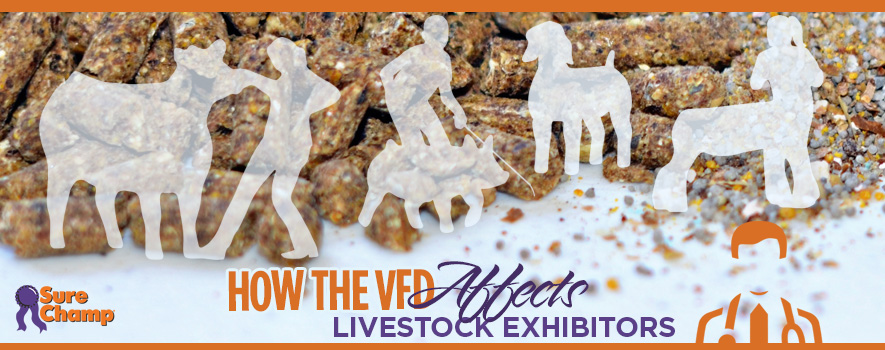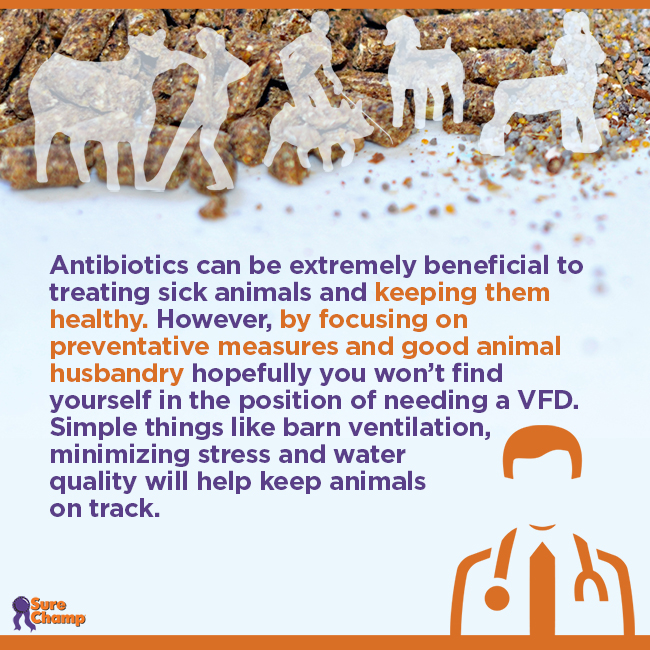
VFD. Have you heard this term yet? VFD stands for the Veterinary Feed Directive and it is going to have a big impact on how you feed your show animals in 2017.
Beginning January 1, 2017 the use of medically important antibiotics in feed or water will fall under the supervision of licensed veterinarians. In order to purchase feed containing antibiotics or antibiotics for administration through water, livestock exhibitors must have a working relationship with their veterinarian. A Veterinary Client Patient Relationship (VCPR) is similar to the relationship one would have with their family doctor. The livestock exhibitor should initiate the VCPR prior to the beginning of the feeding period.
There are three categories of Veterinary drugs regulated by the Food and Drug Administration (FDA).
- Over-the-counter (OTC)
- Prescription (Rx)
- Veterinary Feed Directive (VFD)
 However, starting January 1, 2017 most antibiotics intended for use in feed that are currently classified as “over-the- counter” will become VFD drugs. The antibiotics included are those deemed by the FDA to be medically important to human medicine. Under the new regulations, VFD drugs are FDA-approved for use in animal feeds only under veterinarian supervision and written VFD orders.
However, starting January 1, 2017 most antibiotics intended for use in feed that are currently classified as “over-the- counter” will become VFD drugs. The antibiotics included are those deemed by the FDA to be medically important to human medicine. Under the new regulations, VFD drugs are FDA-approved for use in animal feeds only under veterinarian supervision and written VFD orders.
All feed that contains an additive now considered to be a VFD drug must be labeled as such. However, if you are unsure if an additive qualifies, you can see a full list of the drugs that will be included in the VFD by visiting the U.S. Food and Drug Administration’s website.
If you need a VFD how do you go about getting one?
1. Contact your veterinarian with whom you have a working relationship (VCPR). If you do not have a VCPR with a veterinarian, then the preliminary step is to establish that relationship.
2. In consultation, the veterinarian will determine whether conditions of the livestock exhibitor warrant use of a VFD drug.
3. If warranted, the veterinarian will issue a written and signed VFD order containing information specified by regulations. Verbal orders are not allowed, but electronic orders are acceptable. Incomplete and unsigned orders are invalid and cannot be filled.
4. The veterinarian then retains the original VFD order and gives the completed copies to you.
5. You must keep a copy and give a copy of the VFD to the feed mill or feed distributor supplying the VFD feed. These copies have to be kept for two years. Make sure you keep the VFD in a safe place in case you ever have to provide a copy of it.
6. The VFD order allows the feed to be released to you.
Antibiotics can be extremely beneficial to treating sick animals and keeping them healthy. However, by focusing on preventative measures and good animal husbandry hopefully you won’t find yourself in the position of needing a VFD. Simple things like barn ventilation, minimizing stress and water quality will help keep animals on track. Gut health is also incredibly important to overall health. By feeding a prebiotic such as Amaferm®, found in products such as Sure Champ® or Sure Champ Spark, you can stimulate the good bacteria in the digestive system to ensure your livestock are in optimal health.
For additional recommendation contact your local veterinarian or feed store.
Acknowledgements:
Dr. Thomas Hairgrove, Livestock and Food Animal Systems Coordinator, TAMU Department of Animal Science
Dr. Ted McCollum, Professor & Extension Beef Cattle Specialist, TAMU Department of Animal Science
Dr. Virginia Fajt, Clinical Associate Professor, TAMU Veterinary Medicine & Biomedical Sciences
Dr. Ron Gill, Associate Department Head Extension Animal Science, TAMU Department of Animal Science

